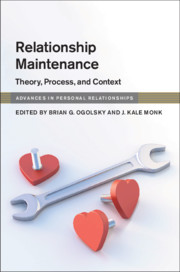Book contents
- Relationship Maintenance
- Advances in Personal Relationships
- Relationship Maintenance
- Copyright page
- Contents
- Tables
- Figures
- Contributors
- Part I Introduction
- Part II Theories of Relationship Maintenance
- Part III Processes of Relationship Maintenance
- Part IV The Social Context of Relationship Maintenance
- Part V Conclusion
- 19 Relationship Maintenance Reprise and Reflections: Past, Present, and Future
- Index
- References
19 - Relationship Maintenance Reprise and Reflections: Past, Present, and Future
from Part V - Conclusion
Published online by Cambridge University Press: 02 December 2019
- Relationship Maintenance
- Advances in Personal Relationships
- Relationship Maintenance
- Copyright page
- Contents
- Tables
- Figures
- Contributors
- Part I Introduction
- Part II Theories of Relationship Maintenance
- Part III Processes of Relationship Maintenance
- Part IV The Social Context of Relationship Maintenance
- Part V Conclusion
- 19 Relationship Maintenance Reprise and Reflections: Past, Present, and Future
- Index
- References
Summary
This chapter serves as the conclusion of a volume on the maintenance of relationships, especially romantic relationships. As its author, I sought to reflect on the other chapters in the book, doing some synthesizing, placing the volume’s contents in context, and adding my own views. The chapter unfolds by first discussing what maintenance is and then examining the past, the present, and the future of scholarship on maintenance. The discussion of the past mapped the growth of work on maintenance and reflects on a few comparisons between early and current contributions. The segment on the present identifies a citation count–based who’s who in the area, compares five theoretical perspectives on maintenance, and offers a broad-stroke synthesis of antecedents and consequences of maintenance. The chapter’s final section looks to the future, highlighting what authors in the volume recommend plus identifying four additional directions maintenance researchers might pursue. Overall, the chapter documents that from maintenance scholarship’s modest beginnings nearly 50 years ago, the volume of research, the sophistication of theoretical analyses, and the variety of research paradigms have all substantially advanced. Maintenance has gone from obscurity to being an important topic in good standing as we approach 2020.
Keywords
- Type
- Chapter
- Information
- Relationship MaintenanceTheory, Process, and Context, pp. 369 - 398Publisher: Cambridge University PressPrint publication year: 2019

